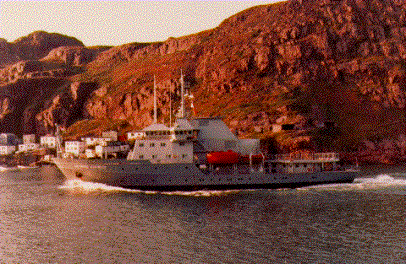CANADA, SPAIN, AND THE EUROPEAN UNION IN THE TURBOT WAR
 |
 |
| These are two of the Canada Patrol ships that seized Spanish and Portuguese fishing trawlers, the Cape Roger (left) and the Leonard J. Cowley (right). | |
Why did this happen?
One issue between the Spanish and Canadians was whether or not Canada had a legal right to seize foreign vessels outside the 200-nautical mile limit of its authority. Within this area, Canada exercises its full sovereignty; it can make laws and enforce them.
Click here to see a map showing the 200 nautical mile limit; note the “nose” and “tail” region off the coast of Newfoundland and Labrador.
The Spanish stated that the Estai was captured outside Canadian waters in the Grand Banks, or “nose and tail” region. Therefore, they said, the Canadian government had no legal right to seize foreign ships.
The Canadian government stated that it acted to conserve dwindling stocks of turbot. Find out what turbot or Greenland halibut or black halibut look like.
The main issue was that the Spanish were accused of catching more turbot than they were allowed to by the North Atlantic Fisheries Organization. (NAFO) Check out the NAFO website and find out how many countries are members. See if you can find fishing quotas for turbot or Greenland Halibut on their website.
Canada and the European Union concluded an agreement in early April 1995 that resolved the conflict between Canada and Spain and protected the turbot from over fishing.
If NAFO is the International Organization that sets fishing quotas, why was the European Union involved in a dispute between Spain and Canada?
Click here to find out why.